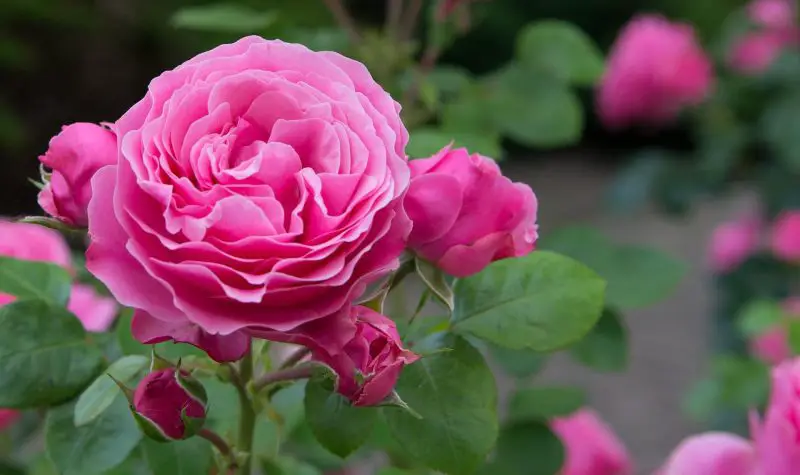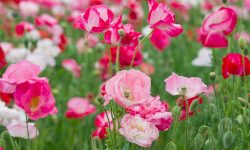Roses are beloved for their stunning blooms, intoxicating fragrance, and timeless elegance in any garden. However, many gardeners find themselves frustrated when their rose bushes produce lush green foliage but no flowers. If you are asking, “Why are my roses not blooming?”, you are not alone. There are several possible reasons, ranging from improper pruning techniques to inadequate sunlight, nutrient imbalances, or even pest and disease issues. Understanding these factors is the first step to encouraging abundant, healthy blooms.
This detailed guide will explore why your roses may not be flowering and provide expert tips to help you restore their blooming beauty quickly.
Understanding the Blooming Cycle of Roses

Before addressing why roses fail to bloom, it is crucial to understand how their natural blooming cycle works. Most modern roses, especially hybrid teas, floribundas, and grandifloras, bloom in flushes throughout the growing season, typically every six to eight weeks. Old garden roses and some shrub varieties may only bloom once in early summer. Each cycle depends heavily on healthy growth, energy stored in the roots, and proper environmental conditions. If your roses are putting all their energy into leaf production rather than flower buds, something is disrupting this natural rhythm. Recognizing the growth pattern of your specific rose variety can help you determine whether the lack of blooms is normal or a sign of a problem.
Common Reasons Roses Fail to Bloom
Insufficient Sunlight Exposure
Roses are sun-loving plants that need at least six to eight hours of direct sunlight daily to produce abundant flowers. When roses are planted in shaded areas or are blocked by taller trees, fences, or buildings, they tend to focus on vegetative growth instead of flower production. Without enough sunlight, photosynthesis slows down, and the plant lacks the energy to form buds. Gardeners who notice healthy foliage but no blooms should evaluate whether their roses are receiving adequate light throughout the day, especially during early morning and midday when sunlight is most intense.
Nutrient Imbalance and Excessive Nitrogen
Fertilizing roses is essential, but overdoing it with high-nitrogen fertilizers can result in thick, leafy growth at the expense of flowers. Nitrogen promotes lush foliage, while phosphorus is crucial for bud formation and root development. If you are using lawn fertilizers or a general-purpose plant food high in nitrogen, this could be the main culprit behind the lack of blooms. Roses thrive when given a balanced fertilizer or one specifically formulated for flowering plants, which contains higher levels of phosphorus and potassium. Regular soil testing can also help determine nutrient deficiencies and guide you toward the right fertilizer choices.
Improper Pruning Techniques
Pruning plays a major role in stimulating rose blooms, but incorrect timing or harsh cutting can prevent flowering. Roses that bloom on old wood, such as some climbers and heritage varieties, should only be pruned after flowering, as cutting too early removes the developing buds. On the other hand, hybrid teas and floribundas benefit from regular pruning in early spring to encourage strong new canes that produce abundant flowers. Over-pruning or cutting back too hard can shock the plant, delaying bloom production for weeks or even an entire season.
Age of the Rose Bush
The age of your rose bush also influences its blooming capacity. Newly planted roses often focus on root development during their first year and may produce very few flowers until they are well established. Similarly, very old roses may have exhausted their energy reserves, especially if they have not been rejuvenated through proper pruning and feeding. Mature bushes with woody, unproductive canes often need to be pruned back gradually over several seasons to encourage vigorous new growth and increased flowering.
Pest and Disease Problems
Pests such as aphids, thrips, and spider mites can attack developing buds, causing them to shrivel or drop before they open. Fungal diseases like black spot, powdery mildew, and botrytis blight can also weaken plants and reduce their ability to produce flowers. Regularly inspecting your roses for early signs of pests and diseases is essential. Healthy, pest-free foliage is critical for photosynthesis, which provides the energy required for bud development. Treating any infestations promptly with appropriate organic or chemical controls can help restore blooming.
Environmental Stress and Weather Conditions
Extreme temperatures, drought, or prolonged rainy periods can stress rose plants, causing them to halt flower production. Roses thrive in mild, consistent conditions with well-drained soil and moderate moisture levels. A sudden heatwave or excessive rain can damage developing buds or encourage fungal growth that affects blooming. Mulching around the base of roses helps regulate soil temperature and moisture, reducing environmental stress that may prevent flowering.
Expert Tips to Encourage Blooming Quickly
Providing Optimal Sunlight and Location
One of the fastest ways to improve rose blooming is to ensure they receive enough sunlight. If your roses are growing in a shaded area, consider transplanting them to a sunnier location in early spring or fall when the weather is mild. For roses growing near trees or tall shrubs, prune nearby branches to allow more light to reach the plant. Remember, at least six hours of direct sunlight daily is the minimum requirement for consistent flowering.
Adjusting Fertilization for Better Flowering
Switch to a rose-specific fertilizer or one labeled as a “bloom booster” with higher phosphorus and potassium content. Apply fertilizer every four to six weeks during the growing season, following the manufacturer’s instructions. Avoid excessive nitrogen, especially if you notice an overgrowth of leaves with no flowers. Adding organic matter such as compost or well-rotted manure improves soil fertility naturally, supporting healthy root development and better bloom production.
Pruning to Stimulate New Growth
Pruning at the right time encourages strong new canes, which are where most flowers form. For repeat-blooming roses, prune in early spring just as buds begin to swell. Remove dead, damaged, or crossing canes to improve air circulation and redirect energy to flowering canes. Deadheading spent flowers regularly also stimulates the plant to produce more blooms by preventing it from focusing on seed production. For old garden roses that bloom once a year, prune immediately after flowering to avoid cutting off next season’s buds.
Controlling Pests and Diseases Effectively
Healthy roses bloom more readily, so protecting them from pests and diseases is essential. Use insecticidal soap or neem oil for aphids and other common pests, and apply fungicides if black spot or powdery mildew becomes a problem. Good garden hygiene, such as removing fallen leaves and watering at the base rather than overhead, helps prevent fungal infections. A strong, healthy rose bush will recover quickly and redirect its energy toward flower production.
Maintaining Proper Watering and Mulching Practices
Roses require deep, consistent watering, especially during dry periods. Water thoroughly at the base once or twice a week, allowing moisture to penetrate the root zone. Avoid frequent shallow watering, which encourages weak root growth and poor blooming. Mulching with organic material such as shredded bark or compost helps retain soil moisture, regulate temperature, and reduce weed competition. Healthy, well-hydrated roots support stronger flowering canes and more abundant blooms.
Rejuvenating Old or Weak Roses
For older roses that have stopped blooming, rejuvenation pruning may be necessary. This involves gradually removing old, woody canes over two to three seasons to encourage new, vigorous growth. Feeding the plant with balanced fertilizers and improving soil health through compost amendments can also help restore flowering potential. In some cases, if a rose is too old or has been severely neglected, replacing it with a new, healthy plant may be the best option.
How Long Does It Take for Roses to Bloom After Fixing These Problems?
Once you address the underlying issues, roses typically respond within one blooming cycle, which can range from four to eight weeks depending on the variety and growing conditions. Some improvements, such as adjusting sunlight exposure or proper fertilization, may show results faster, while severely stressed or over-pruned roses might take an entire season to recover fully. Patience and consistent care are key to restoring abundant, healthy blooms.
FAQs About Roses Not Blooming
Why are my roses not blooming even though they look healthy?
Healthy foliage without blooms usually indicates too much nitrogen or insufficient sunlight. Adjusting fertilization and ensuring at least six hours of direct sunlight daily can encourage flower production.
How long does it take for roses to bloom after fixing the problem?
Most roses respond within one blooming cycle, typically four to eight weeks. However, severely stressed or over-pruned plants may take an entire season to recover fully.
Will pruning help my roses bloom more?
Yes, proper pruning stimulates new cane growth where most flowers develop. Deadheading spent blooms and removing weak canes also redirects energy into forming new buds.
Do roses need special fertilizer to bloom?
Roses bloom best when fed with a fertilizer higher in phosphorus and potassium, often labeled as a bloom booster. Avoid excessive nitrogen, which promotes leaf growth instead of flowers.
Can pests stop roses from blooming?
Yes, pests such as aphids and thrips can damage buds, preventing them from opening. Controlling pests early with insecticidal soap or neem oil helps protect flower development.
Final Thoughts on Restoring Blooming Roses
If you have been wondering, “Why are my roses not blooming?”, the solution lies in understanding what your roses need to thrive. Adequate sunlight, balanced nutrients, proper pruning, pest management, and consistent watering are essential to promoting healthy growth and abundant flowering. By correcting these common mistakes, you can quickly revive your rose bushes and enjoy their stunning blooms throughout the growing season. With a little patience and expert care, even the most stubborn roses can return to their full flowering glory, rewarding you with vibrant colors and a delightful fragrance that enhances any garden.






